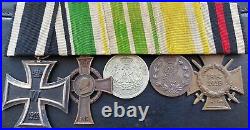
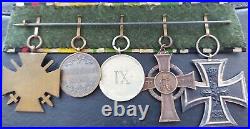
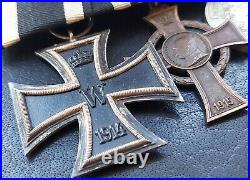
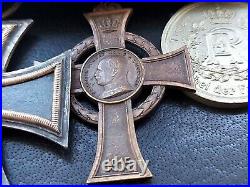
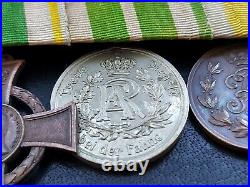
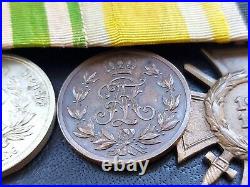
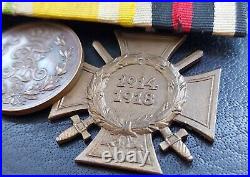
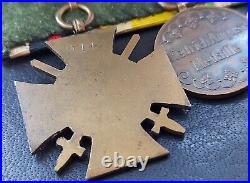
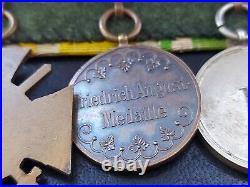
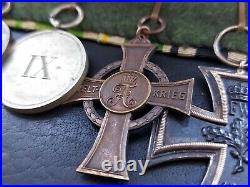
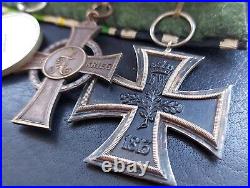
Original German / Saxony mounted medal group: Prussian Iron Cross II. Class, Saxony War Merit Cross, Saxony Long Service Medal III. Class for 9 Years’ Service, Saxony Friedrich August Medal in Bronze & Honour Cross With Swords – WW1, IN VERY GOOD CONDITION, GENUINE RIBBONS, PERFECT PIN DEVICE, THE IRON CROSS IS A THREE PIECE CONSTRUCTION WITH MAGNETIC CORE – A REALLY GREAT PARADE MOUNTED MEDAL GROUPING. HISTORY OF THE AWARDS. Iron Cross (German: Eisernes Kreuz) was a military decoration of the Kingdom of Prussia, and later of Germany, which was established by King Friedrich Wilhelm III of Prussia and first awarded on 10 March 1813 in Breslau. In addition to during the Napoleonic Wars, the Iron Cross was awarded during the Franco-German War, the First World War, and the Second World War. The Iron Cross was normally a military decoration only, though there were instances of it being awarded to civilians for performing military functions. Two examples, the civilian pilot Hanna Reitsch was awarded the Iron Cross First Class for her bravery as a test pilot during the Second World War and Melitta Schenk Gräfin von Stauffenberg (also a German female test pilot) was awarded the Iron Cross Second Class. The Iron Cross was also used as the symbol of the German Army from 1871 to 1915, when it was replaced by a simpler Greek cross. In 1956, the Iron Cross became the symbol of the Bundeswehr, the German armed forces. The traditional design is black and this design is used on armored vehicles and aircraft. A newer design in blue and silver is used as the emblem in other contexts. The Iron Cross is a black four-pointed cross with white trim, with the arms widening towards the ends, similar to a cross pattée. It was designed by the neoclassical architect Karl Friedrich Schinkel and reflects the cross borne by the Teutonic Knights in the 14th century. The ribbon for the 1813, 1870 and 1914 Iron Cross (2nd Class) was black with two thin white bands, the colours of Prussia. The noncombatant version of this award had the same medal, but the black and white colours on the ribbon were reversed. Initially the Iron Cross was worn with the blank side out. This did not change until 1838 when the sprig facing could be presented. Since the Iron Cross was issued over several different periods of German history, it was annotated with the year indicating the era in which it was issued. For example, an Iron Cross from the First World War bears the year “1914″, while the same decoration from the Second World War is annotated “1939″. The reverse of the 1870, 1914 and 1939 series of Iron Crosses have the year “1813″ appearing on the lower arm, symbolizing the year the award was created. The 1813 decoration also has the initials “FW” for King Frederick William III, while the next two have a “W” for the respective kaisers, Wilhelm I and Wilhelm II. The final version shows a swastika. It was also possible for a holder of the 1914 Iron Cross to be awarded a second or higher grade of the 1939 Iron Cross. In such cases, a “1939 Clasp” (Spange) would be worn on the original 1914 Iron Cross. A similar award was made in 1914 but was quite rare, since there were few in service who held the 1870 Iron Cross. For the First Class award the Spange appears as an eagle with the date “1939″ that was pinned above the Cross. Although two separate awards, in some cases the holders soldered them together. A cross was the symbol of the Teutonic Knights (a heraldic cross pattée), and the cross design (but not the specific decoration) has been the symbol of Germany’s armed forces (now the Bundeswehr) since 1871. The Iron Cross was founded on 10 March 1813 in Breslau and awarded to soldiers during the Wars of Liberation against Napoleon. It was first awarded to Karl August Ferdinand von Borcke on 21 April 1813. King Wilhelm I of Prussia authorized further awards on 19 July 1870, during the Franco-German War. The Iron Cross was reauthorized by Emperor Wilhelm II on 5 August 1914, at the start of the First World War. During these three periods, the Iron Cross was an award of the Kingdom of Prussia, although given Prussia’s pre-eminent place in the German Empire formed in 1871, it tended to be treated as a generic German decoration. The 1813, 1870, and 1914 Iron Crosses had three grades: Iron Cross 2nd Class German: Eisernes Kreuz 2. Klasse, Iron Cross 1st Class German: Eisernes Kreuz 1. Klasse, Grand Cross of the Iron Cross (German: Großkreuz des Eisernen Kreuzes, often simply Großkreuz). Although the medals of each class were identical, the manner in which each was worn differed. Employing a pin or screw posts on the back of the medal, the Iron Cross First Class was worn on the left side of the recipient’s uniform. The Grand Cross and the Iron Cross Second Class were suspended from different ribbons. The Grand Cross was intended for senior generals of the German Army. An even higher decoration, the Star of the Grand Cross of the Iron Cross, was awarded only twice, to Field Marshal Gebhard von Blücher in 1813 and to Field Marshal Paul von Hindenburg in 1918. A third award was planned for the most successful German general during the Second World War, but was not made after the defeat of Germany in 1945. The Iron Cross 1st Class and the Iron Cross 2nd Class were awarded without regard to rank. One had to already possess the 2nd Class in order to receive the 1st Class (though in some cases both could be awarded simultaneously). The egalitarian nature of this award contrasted with those of most other German states (and indeed many other European monarchies), where military decorations were awarded based on the rank of the recipient. For example, Bavarian officers received various grades of that Kingdom’s Military Merit Order (Militär-Verdienstorden), while enlisted men received various grades of the Military Merit Cross (Militär-Verdienstkreuz). Prussia did have other orders and medals which were awarded on the basis of rank, and even though the Iron Cross was intended to be awarded without regard to rank, officers and NCOs were more likely to receive it than junior enlisted soldiers. In the First World War, approximately four million Iron Crosses of the lower grade (2nd Class) were issued, as well as around 145,000 of the higher grade (1st Class). Exact numbers of awards are not known, since the Prussian archives were destroyed during the Second World War. The straight-armed Balkenkreuz, the emblem of the Wehrmacht, first used in a narrower form on Luftstreitkräfte aircraft in mid-April 1918, and as shown here, as it appeared on German planes, tanks, and other vehicles during the Second World War. They restored the Iron Cross in 1939 as a German decoration (rather than Prussian as in earlier versions), continuing the tradition of issuing it in various grades. Legally it is based on the enactment Reichsgesetzblatt I S. 1573 of 1 September 1939 Verordnung über die Erneuerung des Eisernen Kreuzes (Regulation for the Re-introduction of the Iron Cross). The Iron Cross of the Second World War was divided into three main series of decorations with an intermediate category, the Knight’s Cross, instituted between the lowest, the Iron Cross, and the highest, the Grand Cross. The Knight’s Cross replaced the Prussian Pour le Mérite or “Blue Max”. They did not care for the Pour le Mérite, as it was a Prussian order that could be awarded only to officers. The ribbon of the medal (2nd class and Knight’s Cross) was different from the earlier Iron Crosses in that the color red was used in addition to the traditional black and white (black and white were the colours of Prussia, while black, white, and red were the colors of Germany). They also created the War Merit Cross as a replacement for the non-combatant version of the Iron Cross. The edges were curved, like most original iron crosses. The standard 1939 Iron Cross was issued in the following two grades: Iron Cross 2nd Class Eisernes Kreuz 2. Klasse, Iron Cross 1st Class Eisernes Kreuz 1. Klasse abbreviated as EKI or E. The Iron Cross was awarded for bravery in battle as well as other military contributions in a battlefield environment. The Iron Cross 2nd Class came with a ribbon and was worn in one of two different methods: when in formal dress, the entire cross was worn mounted alone or as part of a medal bar, for everyday wear, only the ribbon was worn from the second hole in the tunic button. The Iron Cross First Class was a pin-on medal with no ribbon and was worn centered on a uniform breast pocket, either on dress uniforms or everyday outfit. It was a progressive award, with the second class having to be earned before the first class and so on for the higher degrees. It is estimated that some four and a half million Second Class Iron Crosses were awarded in the Second World War, and 300,000 of the First Class. Saxony – War Merit Cross (German: Kriegsverdienstkreuz) was a military decoration of the Kingdom of Saxony. Established 30 October 1915 by King Frederick Augustus III of Saxony, it was awarded for humanitarian and patriotic work towards the war effort. The War Merit Cross is made of bronze and in the shape of a Latin cross pattée. Between the arms of the cross is a laurel wreath. The obverse bears a circular medallion in the center with the left facing effigy of King Friedrich August III. Circumscribed around the medallion is FRIEDRICH AUGUST KÖNIG V. In the upper arm is the Saxon crown and the date 1915 on the lower arm. The reverse of the central medallion bears the crowned cipher of King Friedrich August III. The left arm is inscribed WELT- and the right arm inscribed KRIEG (World War). Saxony Long Service Silver Medal for Non-Commissioned Officers, III class for 9 years service SACHSEN-Königreich. The medal instituted in 1913 in three grades, for 15, 12 and 9 years service, replacing the model introduced in 1874. Saxony Friedrich August Medal – circular bronze medal with laterally pierced loop for ribbon suspension; the face with crowned cipher of King Friedrich August III within a laurel wreath; the reverse inscribed Friedrich August Medaille, the Saxon rue wreath above and below; on replaced correct ribbon. The Medal was instituted by King Friedrich August III on 23 April 1905 to be awarded in recognition of meritorious service by servicemen from sergeant downwards and civil persons of similar rank in war and peace (zur Anerkennung verdienstlicher Leistungen bei Mannschaften vom Feldwebel abwärts und diesen im Range gleichstehenden Zivilpersonen im Kriege und Frieden). Cross of Honour, also known as the Honour Cross or, popularly, the Hindenburg Cross, was a commemorative medal inaugurated on July 13, 1934 by Reichspräsident Paul von Hindenburg for those soldiers of Imperial Germany who fought in World War I. It came in three versions: Honour Cross for Combatants (Ehrenkreuz für Frontkämpfer) – for soldiers who fought on the front, Honour Cross for War Participants (Ehrenkreuz für Kriegsteilnehmer) – for non-combatant soldiers, Honour Cross for Next-of-Kin (Ehrenkreuz für Hinterbliebene) – for the next-of-kin of fallen soldiers. After the annexation (Anschluss) of Austria in 1938, Austrian veterans of World War I were also eligible for the Cross of Honour. A total of 6,250,000 Crosses were awarded to combatants, 1,200,000 were awarded to non-combatants and 720,000 medals were awarded to next-of-kin. A variation with an anchor in the center, and referred to as the Naval Cross, was issued to veterans of the Imperial German Navy. The Honour Cross for War Participants differed from the Honour Cross for Combatants by not having the crossed swords. The Honour Cross for Next-of-Kin also lacked swords, was lacquered in black, and had a different ribbon. The medal is suspended from a ribbon with a thin black lines of its sides, a red line in the center and next to it a black and white lines on each side, on the next-of-kin medal the ribbon colors are reverse. The item “10795 German Saxony WW1 mounted medal group Iron Cross War Merit Cross” is in sale since Friday, October 8, 2021. This item is in the category “Collectables\Militaria\World War I (1914-1918)\Medals/ Ribbons”. The seller is “a..anderson” and is located in Abbots Langley. This item can be shipped worldwide.
- Country/Region of Manufacture: Germany
- Country/ Organization: Germany
- Theme: Militaria
- Featured Refinements: Iron Cross
- Type: Medals & Ribbons
- Conflict: World War I (1914-1918)
- Era: 1914-1945